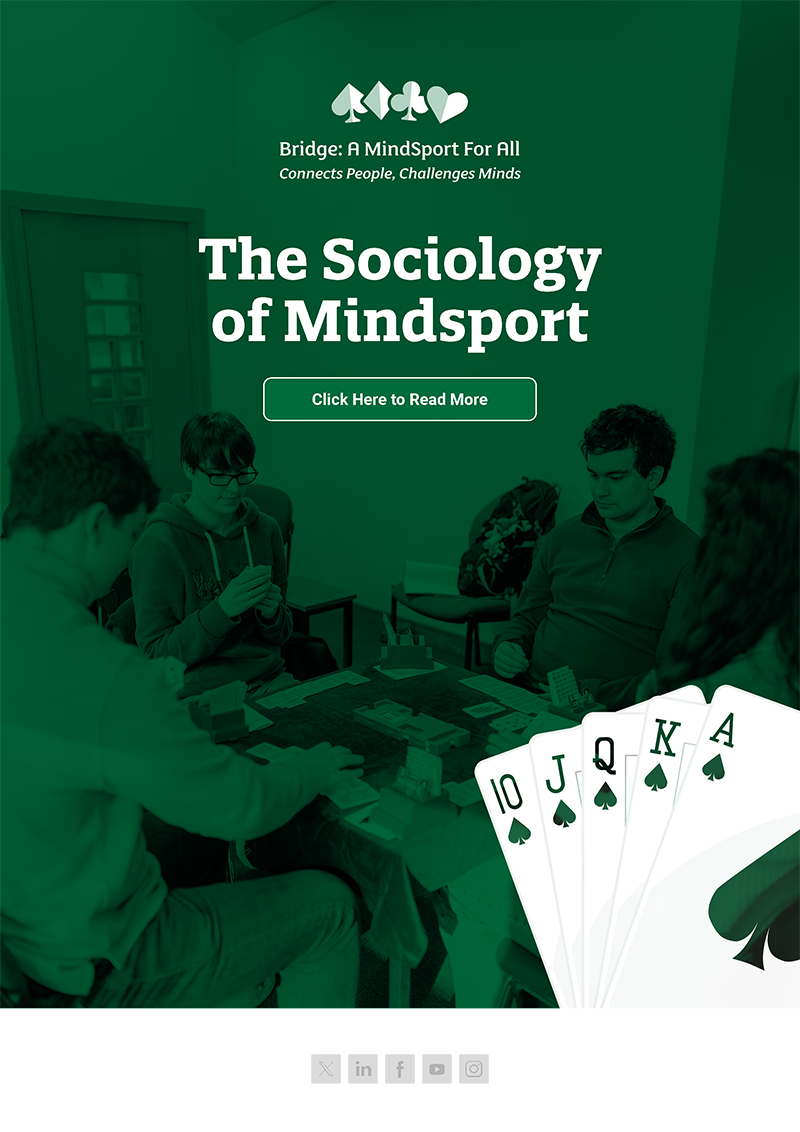The game of contract bridge, as we know it today, originated in the 20th century – but what lies ahead for bridge as a mind sport? Professor Samantha Punch, the academic behind “Bridge: A MindSport For All”, provides the answer
Bridge is a trick-taking card game played in partnership that has captured the hearts of hundreds of millions of players worldwide. Top players describe it as a “passion” and an “adrenalin rush.” It involves a very low level of chance and offers a new puzzle to solve every 71⁄2 minutes (the time spent per deal in tournament games). Yet bridge and other mind sports like chess have not gained widespread recognition as sports, and as such, do not stand on an equal footing with traditional sports.
What can be done to further popularise and reinvigorate the once-favourite pastime of households in the 1930s and transform bridge into a global phenomenon? That is what the Bridge: A MindSport For All organisation, based at the University of Stirling, explores through its diverse portfolio of research projects.
“Bridge: A MindSport For All”
Bridge: A MindSport For All (BAMSA) was established in 2016 to explore a new and innovative field of study called “the sociology of bridge”. Sociology investigates the constituent parts of societies, such as institutions and communities, and the relationships between them. While this domain has been previously applied to the study of sports and leisure, its remit has not extended to the study of the bridge as a mind sport. For this reason, Prof Samantha Punch at the University of Stirling spearheaded the movement to understand different aspects of bridge, including motivation, emotion, partnership, professionalisation, identity and gender.
The BAMSA campaign received the endorsement of international bridge organisations such as the World Bridge Federation, the American Contract Bridge League Educational Foundation, and the European Bridge League. It led to the formation of a network of research associates, bridge stakeholders, and policymakers from all over the world. To date, BAMSA’s work has resulted in the development of eight major research projects, driven by one key goal: to ensure that everyone can benefit from learning and playing bridge and that this fascinating game will continue to thrive.
The benefits of bridge
BAMSA’s research has uncovered many important facets of bridge, and evidenced the benefits of mind sports. At a fundamental level, bridge is a form of serious leisure that evokes a sense of thrill, competition, and flow. In examining the game in more detail, Prof Punch and Dr Snellgrove found that bridge fosters a host of life skills in players. Their recent study indicates that interpersonal and life skills are developed and sharpened through strategic interaction at the bridge table. Players develop key abilities such as anticipating their opponents’ moves while strategically planning their own moves, responding to the dynamic nature of the game and adapting their strategies accordingly, maintaining composure and recovering from mistakes, and effectively communicating with their bridge partners to develop routines and shared understandings.
These soft skills are invaluable not only in the context of bridge playing but also in everyday life. Indeed, in a 2016 study that compared 7,000 bridge players with 10,000 non-bridge players, BAMSA found that bridge players are more likely than non-bridge players to be optimistic about their future and to be satisfied with the way their lives have turned out. The bridge players also noted that bridge improves their concentration, memory, sociability and wellbeing.
BAMSA’s latest research on the physicality of bridge challenges the notion that bridge and mind sports are not sports. This BAMSA evidence paints a compelling picture: through their participation in mind sports, bridge players hone their resilience, quick decision-making, and emotional intelligence. Players excel not only at bridge but also in their professional and social lives.
Ushering in a new generation of mind sports players
To raise the profile of mind sports and introduce bridge to a new generation of players, BAMSA recently launched its “Bridge, Youth, and Mindsport Education” project. This study explores the factors that help and hinder young people’s bridge learning in primary and secondary schools in Europe and North America.
The incorporation of bridge into the school curriculum is promising. The explosion of young people’s sports participation – in the form of e-sports – has already changed our understanding of ‘sport’, and bridge is set to usher in a similar sports renaissance. That is because bridge combines two tried-and-tested elements crucial to the proliferation of popular sports: a strategic element and a social element. Like chess, bridge is intensely intellectual; like e-sports, bridge is highly sociable.
The collaborative efforts of schools, bridge organisations, policymakers, and the International Mind Sports Association will be fundamental to developing an international mind sports and bridge agenda for youth.
An important part of this agenda will be applying the benefits of bridge and mind sports education to enhance the school curriculum. Youth bridge can offer solutions to many of the current challenges faced by schools related to numeracy, inclusion, social connection, mental health, and wellbeing.


